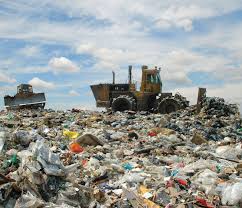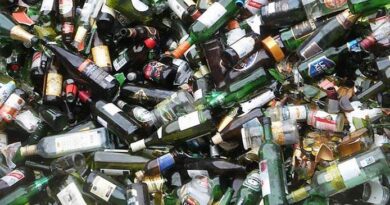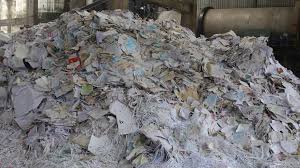Environmental and Social Impacts of Waste and Waste Management Strategies
While the environmental issues associated with the accumulation and processing of waste may be apparent, there are other impacts to be considered. In addition to affecting natural systems, waste can negatively impact human health through water, soil, and air contamination, reduce property values near processing facilities, and can be expensive to implement and maintain, putting stress on municipal and city budgets.
Over the last century humans have created a significant volume of waste materials, many of which release chemicals as they breakdown. In some cases, these chemicals can be the cause of significant issues for human and animal health and impact ecosystem function.
1. Soil and Water Contamination
Contamination refers to the introduction of an undesirable substance into the environment which can originate from both natural and anthropogenic sources. Once introduced, the effects of contamination can spread and effect a larger geographic area though ground and surface waters. Contaminants can also be airborne.
When contaminates can be linked to a specific source, such as a landfill, it is referred to as Point Source Pollution. Many factors influence the mobility and bio availabilityof contaminants such as pH, soil texture, and soil organic matter. Given the complexity of hydrological systems, contamination can be extremely challenging to predict and remediate. Prevention is the best method.
While landfills provide economic means of solid waste management, improper or poorly engineered landfills are a threat to the environment (Tammemagi, 1999). If not properly sealed from the surrounding environment, landfills can impact ground water through the release of leachate.
Leachate is a toxic substance that is created when water generated from precipitation or the breakdown of organic matter passes through a landfill and extracts suspended or dissolved matter from the waste present (Raghab et al., 2013).
The way leachate interacts with natural systems is highly dependent on the composition of the leachate, which itself is dictated by the composition of waste where it is formed. Examples of leachate impact could include eutrophication, severely reduced water quality, and the introduction of heavy metals into the food web though bioaccumulation (James, 1977).
Read Also : Proper Methods of Waste Management
In addition to leachate, landfill gas contains a high concentration of carbon dioxide which can significantly contribute to groundwater pollution due to its high solubility (El-Fadel et al., 1997).
Long term exposure to contaminated soils can affect the genetic makeup of the human body, causing congenital anomaliesand chronic health problems that cannot be easily cured. Some health effects include liver toxicity, kidney failure, and neurological diseases (Carre et al, 2015). The health effects of soil contaminants depend on a variety of factors, such as the nature of the pollutant, mode of attack and vulnerability of the exposed population.
2. Wildlife and Plastics
Plastic products are all around us; in our homes, workplaces, landfills and sometimes rivers, lakes, and oceans. In 2018 alone, 359 million metric tons of plastics were produced globally (Garside, 2019).
While many cities and municipalities collect and process plastics, an estimated 8 million tons still find their way into oceans annually, representing nearly 80% of all marine debris (IUNC, 2019).
Plastics are more than just unsightly additions to the ocean – they can cause a host of issues for aquatic life. Wildlife may accidentally consume or become entangled in plastic left floating in the ocean, both of which potentially leading to the death of the animal in question.
Plastics can further disrupt ecosystems as they break down into microplastics, a classification of plastics 5 mm or smaller (Canadian Wildlife Federation, n.d.). These microplastics can be generated in many ways, including the decomposition of larger pieces of plastic, microbeads from personal care items, and synthetic fibres.
Millions of marine animals are estimated to be harmed by plastics every year. Nearly 700 species, including species at risk, are known to have been affected (Parker, 2019).
Observed impacts have included altered feeding behaviors, impaired reproductive success and in extreme cases starvation (Royte, 2018). The following are just a few examples of how marine plastics are known to impact common aquatic species.
ZOOPLANKTON
Even the smallest creatures are being affected by plastics. Laboratory evidence has shown that many zooplankton taxa mistake microplastics for food and ingest them readily.
Microplastics can impair their feeding through obstruction of their feeding appendages and reduce the reproductive success of affected zooplankton. (Botterell et al, 2018).
Plankton are a crucial food source for many aquatic animals, including invertebrate filter feeders, predators, and large mammals. As such, healthy populations of zooplankton are important. Researchers are concerned that these organisms provide an entry point for microplastics into the food web which will cause damage as they bioaccumulate up trophic levels (Cole et al., 2013).
FISH
Plastics are having a negative impact on both marine and freshwater species of fish.
In a local example, researchers have found synthetic polymer fibres and plastic pellets in the digestive tracts of fish in Lake Erie. As these microplastics move through the fishes’ digestive tracts, contaminants are absorbed, which lead to liver damage (Bhakta & Derksen, 2015).
SEA TURTLES
In Atlantic Canadian waters, Leatherback Sea Turtles usually feed on Lion’s Mane and Moon Jellyfish, both of which could be easily confused with marine debris such as plastic bags and deflated balloons.

Once ingested, plastic can cause internal blockages causing a turtle to starve, or it can prevent them from properly absorbing the nutrients needed (NOAA, 2014). Other species of sea turtle such as Green, Olive Ridley, and Loggerhead are also at risk to varying degrees depending on their feeding habits (WWF, n.d.).
MARINE MAMMALS
According to the U.S. National Oceanic and Atmospheric Association, nearly 100,000 marine mammals die as the result of trash (NOAA, 2014). Baleen whales like the North Atlantic Right Whale feed by opening their mouths wide on the surface of the water catching copepods and other invertebrates in their mouths and filtering sea water out in a process known as filter feeding. Unfortunately, as a result of this feed technique plastics can enter into the whales’ digestive system.
Plastics can also leach chemical compounds into the water as they break down, further impacting ecosystems and wildlife. These plastic chemicals are among the contaminants that appear to be affecting the St. Lawrence estuary population of Beluga Whales.
It has been found that these Belugas have the highest rates of cancer and carry one of the largest amounts of contaminants of any mammals. It is suspected that chemical contaminants are leading to this cancer, as well as the mortality and reproductive issues facing this marine mammal (Martineau et al., 2002).
Social Impacts
Waste and waste management strategies have significant impacts on society. In Ontario, a social impact of waste management revolves around the location of processing and storage facilities.
A series of studies published in the 1990’s examined the psychosocial effects on populations living within proximity to solid waste disposal facilities, specifically landfills as well as an incinerator in southern Ontario.
Researchers studied the ways in which residents experienced the facilities and the impacts on their daily lives.
The main concerns expressed from residents near landfills included increased traffic, flocks of scavenging birds, poor water quality, and poor property values.
Conversely the major concerns from residents near the incineration unit related to air quality, stack emissions and odours. The study also found that residents lacked trust in local government and authorities in making proper decisions for the community (Eyles et al., 1993).
Society and waste are also linked through everyday rituals, behaviours, local initiatives, and legislation at the municipal, provincial, and federal level.
Exposure to waste reduction initiatives such as recycling, composting, and sustainable consumption can be influenced by individuals’ experiences, geography, and socio-economic status which in turn impacts the level to which an individual will participate.
Education is vital when it comes to better understanding waste management options. Getting involved in school programs and initiatives such as recycling programs, community composting, and neighbourhood cleanups reduce the amount of waste entering our natural ecosystems and strengthens communities.
Waste is frequently processed, treated or stored in locations removed its point of creation at the regional, national, and international levels. Until recently, there was a large international trade in plastics and other recyclable materials, with richer industrialized nations shipping waste to poor countries with looser environmental regulations.
The resulting environmental and social impacts have resulted in many countries closing their boarders to the international garbage trade.
Economic Impacts
Waste management represents a significant cost for many municipal governments in Canada (AMO, n.d). Depending on the methods employed and the financial mechanisms introduced, waste management can have varying impacts on the economy.
A report published by The Conference Board of Canada claims that diverting significantly more waste could increase employment and economic activity in Ontario, while reducing the province’s dependence on U.S. landfills in Michigan and New York state (Knowles & Gill, 2014).
The studies presented in the report suggest that increasing Ontario’s waste diversion from its current 23% to 60% would support the equivalent of an additional 12,700 direct and indirect full-time jobs and add $1.5 billion to provincial GDP. It is important to note that the benefits are only attainable once the 60% diversion rate is reached and maintained.
The report concluded that for every 1,000 tonnes of waste diverted in Ontario, at least two jobs are supported.
These numbers might seem optimistic, but it is important to consider how regulations and policies achieve waste diversion goals with varying economic implications.
These implications vary by region and depend on several factors, such as structure of local economy, sector wage, targeted materials, repurposing of diverted materials, and the degree to which regions import waste services. Policymakers must consider these factors in order to ensure that economic opportunities are maximized and that political consequences are evaluated (Knowles & Gill, 2014).
Litter removal is often a hidden cost within waste management, which can make it difficult to determine the actual cost to local governments. Litter costs are also not included as a budget line item, making it difficult to determine the time spent on cleanups.
Local governments spent $2.6 billion on waste management in 2008, up from $2.1 billion two years earlier. Of the total, $1.1 billion went to waste collection and transport, $465 million to run disposal facilities and $368 million for tipping fees (Statistics Canada, 2018).
The cost of transporting waste in Canada is a major issue and is one of the largest costs associated with waste management. The transportation of waste also has many environmental, social, and economic repercussions.
Transporting waste increases the number of vehicles on roadways both between the location of production and treatment, creating air and noise pollution, congestion, and other problems relating to road transport.
The potential for the release of contaminants during the transportation of waste varies; the more hazardous the waste and the larger the volume that is transported, the more devastating the impact on environmental and human health if an accident occurs.
Traffic accidents or train wrecks can result in waste spills and releases of pollutants that may contaminate the air, water, and soil. Waste may also be released while being loaded or unloaded during transportation.
With the increasing amount of waste, there is an increasing demand in space, resulting in many potential landfills being located far from where the actual waste is being generated.
Read Also : Environmental Life Cycle Assessment
This adds significant transportation costs, results in the release of GHG’s and, as mentioned in section 4.2, disproportionally affects communities not responsible for the generation of the waste in the first place.
KITCHEN
If you’re trying to spruce up the kitchen and make it greener here are some things you can change to make a difference.
- When buying new cooking utensils buy wood or metal instead of plastic.
- Go green with groceries! Cut out those plastic bags and buy in bulk when you can to cut down the number of trips you need to make to the store.
- Make the most of the plastics you have. It can be hard to get rid of plastics entirely so instead of throwing out plastic tubs or containers use them for snack containers for your lunch.
BATHROOM
When you’re trying to green up your clean up, here are a few things to consider making your bathroom as green as it can be.
- Ditch those microplastics! Microplastics are found in many exfoliating washes and scrubs try swapping these products out for a natural brush and get just as clean while staying green.
- Buy shampoos and conditioners in bulk, this reduces the number of bottles you need to use.
- Go old school, get rid of body washes for a good old bar of soap this reduces plastics used while still getting the job done.
LAUNDRY ROOM
Time to freshen up laundry day; try some of these green alternatives to clean your clothes and the planet:
- Choose natural fabrics for your clothes. Artificial materials from clothing don’t break down as easy as natural products, by switching to a more natural wardrobe you can reduce the amount of pollutants coming from your laundry.
- Use natural detergents in your wash; this reduces chemical entering water ways through wastewater.
- Buy in bulk reducing the plastic needed to store the detergent.
- It’s time for an upgrade! Upgrading your appliances in the laundry room will both save energy and better filter out wastes from entering waterways.
BEDROOM
There are some easy solutions to reduce the waste that comes from your bedroom:
- Buy natural bedding. This easy switch from artificial fabrics like polyester to silk will keep harmful materials out or the environment and keep you warm at night.
OUT AND ABOUT
Whether you’re hanging out with friends or heading to class always remember to bring the green with you when packing for the day:
- Say NO to straws! Minimize your plastic intake by not using plastic straws. If you need one bring your own, there are plenty of options to buy reusable straws.
- Bring your own utensils. Wood or metal utensils are a great alternative to conventional plastic.
- Ditch the plastic water bottles. Get a reusable bottle; this will reduce the amount of plastic you use daily.
- Don’t want to waste the food you can’t finish? Bring your reusable container to put the leftovers in; this will help say no to single use takeout containers and lower food waste all at once.



